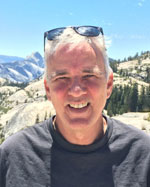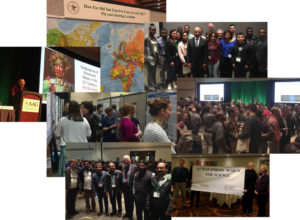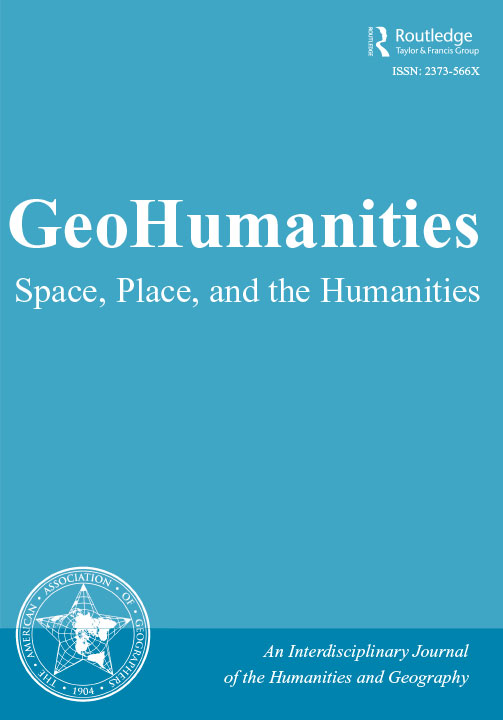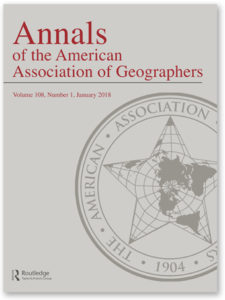Upon Reflection
 How fast time flies. It is hard to believe that the end of the academic year is upon us, June has come and I am writing my last president’s column. I want to use the opportunity provided by this final column to reflect upon the past year. I also want to look ahead and consider the role of our discipline and the American Association of Geographers as we face the changing and challenging world ahead of us. Finally, I hope with one last act as president to give back a little for all I have received.
How fast time flies. It is hard to believe that the end of the academic year is upon us, June has come and I am writing my last president’s column. I want to use the opportunity provided by this final column to reflect upon the past year. I also want to look ahead and consider the role of our discipline and the American Association of Geographers as we face the changing and challenging world ahead of us. Finally, I hope with one last act as president to give back a little for all I have received.
I will start by saying what an honor and pleasure it has been to serve as your president. I have met so many wonderful geographers and learned so much. I am in awe of how smart and dedicated our members are. The heartfelt concerns about geography, society at large and the environment that so many of you have communicated to me have helped me focus on what is really important. Personally, the friendship and kindness shown to me at our regional meetings, annual meeting and council meetings leaves me with warm and indelible memories. I am not too proud to admit I have had my share of uncertainties, and a few faltering steps, over the past year. The patience and good humor shown by the membership, council and staff have been much appreciated and kept things on a good course. Thank you all.
Now, here are some candid reflections and ruminations that I want to share.

On Governance, Policy and Communication Between the AAG and the Membership
I was happy to see that in many cases when geographers had concerns about the AAG they felt free to email me, our Executive Director Doug Richardson, or other members of the council and expressed those concerns with clarity and friendliness. That is how it should be. The AAG is not governed by some aloof cabal of “others” or a disassociated elite. The members of council are you — geographers from both large and small educational institutions. Geographers from the private sector and government agencies. Geographers from every part of the country and other nations. Geographers who really care and are willing to spend their time — unpaid and often unheralded — working for our discipline and our association. The members of council with whom I have worked as president are some of the finest and most genuinely caring people I know.
I have seen how the council takes the concerns of our members very seriously and is willing to act upon those concerns when possible. This is not the Titanic — the association can change course when needed. Over the past year we received letters and petitions concerning things such as refund policies in light of U.S. immigration rules or the engagement of the military with geographical education and research. In these cases, the council revised our refund policy and is now developing a committee to examine engagement between the military and geography.
Because public policy issues have increasingly come to the fore for the AAG and require fair consideration and action when appropriate, I asked Past President Sarah Bednarz to strike a small committee and look into how the AAG should handle issues of public policy, particularly when petitioned by our members. Please remember that the AAG has a constitution and articles of constitution that prescribe the policy areas and actions we as an association can embrace. Based upon Sarah’s excellent report, the AAG has put into place a formal mechanism to make sure that such policy-related requests are handled fairly and thoughtfully. The formation of a special committee to examine issues pertaining to the discipline of geography and the military is an example of that process at work.
Alas, I have also encountered a few cases where public statements and invectives were made without actually contacting council members, staff or even reading the information posted on our website and provided in our electronic communications to members. Although I regret such instances, I mean no disrespect here. I realize that there are issues that move people passionately. Some members may not know any of the elected officials or feel comfortable sending a “stranger” an email about a question or concern, and the time to exhaustively search for information online may be in short supply for many of us. In the end, my feeling is it is better to be heard than be silent.
I will make two humble suggestions to you. The first is — please do communicate with the association. Take a look at the AAG website for information, and if you don’t find it, feel free to send an email to your regional representative or other members on council for help or to express concerns. This association is governed by members just like you for the benefit of all members. By communicating with us you can affect change. The second suggestion — join in our governance yourself. Serve on regional and national committees. Run for elected office. Yes, you! Not only can you help steer this great association and influence our discipline, but you will meet some of the most wonderful people in the world. I cannot over-emphasize how rewarding this can be, or how much we need our members to pitch-in.
On Communication with the Wider World
Geographers have so much to share with the wider world. I have been pleased to see how the AAG develops statements and communication initiatives on issues that concern the discipline and membership. I have also been pleased by the times I have seen geographers in the media commenting on exciting new research or current events. However, I think we can do more. I look at the great success that the American Geophysical Union has in getting press coverage for research presented at their annual meeting. I commissioned Vice President Derek Alderman to strike a committee and look into how the association can up its game in terms of public communication. Derek came up with some very exciting proposals and I look forward to him as president working with AAG staff and membership to take the association to the next level. I urge our membership and specialty group leadership to work with Derek in identifying and helping broadcast our most compelling research and insights.
As I have written before, better communication about geography and geographers also requires each of us to do our part. Please do get to know your campus communication officers. Don’t be afraid to share your work with the public. When an issue moves you, take to the keyboard and write an op-ed for the newspaper. We all have a lot to tell the world.
The Growth and Internationalization of Our Association
It is gratifying to see our membership climb to a record level of almost 12,000. Fantastic. This growth bodes well for the future of the association and our discipline. However, it does come with some challenges. First, about a third of our membership and meeting attendees are from outside the U.S. The AAG has become a vibrant world marketplace for the discipline of geography. Are we serving both our domestic and international membership well? I was concerned about our international members and our professional non-academic members getting good value from the AAG. I asked council members Stuart Aitkin and David DiBiase to strike small committees to examine how we could improve service to our international and professional members respectively.
Stuart and his team tabled a report that amongst other things pointed out that the exclusionary border and immigration policies propounded by the Trump Administration in the U.S., were posing serious challenges for our international membership. In some cases members were officially excluded from attending the annual meeting and others felt personally uncomfortable traveling to the U.S. In other cases, some international members felt compelled to boycott meetings in the U.S. in solidarity with those excluded by border and immigration policies. The AAG continues to oppose such exclusionary and discriminatory policies and to work for solutions. How do we monitor this situation and accommodate members? How can we influence changes in such policies? We need all your help here.
In addition, some international members felt out of the loop in terms of AAG governance. Although any member can run for office, the term “national councilor” does imply a domestic focused position. After discussion, council would like to remedy this by perhaps focusing one of the present councilor positions on international representation. Perhaps slightly changing the name national councilor to national and international councilor would also better reflect the international scope of the AAG? We would like consensus on how to move forward here. Please do help your with your thoughts and suggestions. Council will continue to work on this at the fall meeting.
David found that for many professional members there was a desire to remain engaged with academic geography, but the annual meeting and our publications were not as industry and applications focused to be of practical value in many cases. Council would like to work on this and needs your thoughts and ideas. One suggestion was twin some of our annual meetings with more applied and professional-oriented meetings.
The Growth of Our Annual Meetings and the Increasing Importance of the Regions
Our annual meeting in Boston was a record breaker with more than 9,400 attendees. Although the growth of the meeting is satisfying in many regards, it is not without costs. With a plethora of concurrent sessions and other events it may seem that one misses more sessions of interest than one actually attends. In addition, I noted that many sessions at the Boston meeting had only a small handful of members there to hear the hard work of the presenters. This is a shame. We have not moved to a model of decreasing oral presentations through vetting abstracts. Should we do so? Can we institute more concise time limits — say 10-minute maximums for most presentations? Is it possible to promote poster sessions more, such as the AGU has done successfully? Can we shift the proportion of poster to oral presentations in a voluntary manner?
A meeting that involves more than 9,000 people also limits the cities that can host us. Many places in which we would enjoy congregating simply do not have the hotel rooms, conference facilities or travel infrastructure to host the meeting. Many of the cities that do offer these services are also expensive in terms of hotel rooms. I have seen firsthand how hard our executive director and the AAG staff work to find suitable venues and keep costs low. I have also learned that arrangements for a meeting this size must be made several years in advance. The logistics are incredible. Of course, aside from the limitation on potential host cities and the costs of attending the meetings, the size of our annual gathering also means something is lost in terms of the intimacy and sense of community that is engendered. Alas, I am not sure there is much to be done about these issues short of shrinking the size of the annual meeting.
In light of this all I want to emphasize the importance of our regional meetings in providing venues at which a wide range of talks can be given and heard effectively. A sense of intimacy and community pervades the regional meetings and interesting new towns and cities can be experienced at often reasonable costs. One of the greatest pleasures of being president was the chance to attend regional meetings around the country. I cannot adequately express how much I enjoyed this and how much geography I learned. My faculty and student hosts were so gracious and the enthusiasm of the attendees about geography was energizing. The AAG should do all it can to promote our regions and their meetings. Alas, in some regions the larger research departments seem very uninvolved with the regional meetings. I think this is a shame for faculty and particularly for undergraduate and graduate students. I will confess that I and my department are as guilty of this as many. I am going to work hard to address this — and plan to rent a van to take some of our UCLA students up to the APCG meeting in Chico this fall. Join us there!
Healthy Departments and a Healthy Discipline
Given the growth of the AAG itself, it came as an awakening to me how many departments are finding it difficult to grow or even sustain numbers of majors. With geographical awareness, perspectives and techniques exploding across the natural sciences, social sciences and humanities we as a discipline should be at an exciting growth point. What is going on? In some states the population size of university-aged people is declining and many departments are having trouble maintaining student numbers. However, this is not universal. It is a fact that geography departments do face competition for student interest from expanding environmental studies, earth systems sciences, sustainability, global studies and development studies departments. We should not castigate these programs, as they seek to produce graduates well-trained to tackle the challenges of the 21st century. However, we should also not shirk from proudly promoting our own discipline. Part of this must involve thinking about how we market the discipline. What does a course title such as “Introductory Physical Geography 1” denote to a brand new freshman? Not much I would guess. How about considering something like “Our Dynamic Planet — Processes of Physical Change on the Earth’s Surface”? You get the idea. Aside from naming courses — are our courses exciting and compelling in terms of content and student experience? Do we offer courses that speak to the challenges of the 21st century and the importance of geographical perspectives and methods in tackling those challenges? How often do we as faculty and geography students speak to undergraduate groups and clubs about the discipline? Do we speak and provide resources to high schools and community colleges to get geography on student’s radars? Do we work to get articles about geography in student newspapers? Do we generously provide service courses for other majors? No small number of undergraduate geography majors come to the discipline through elective courses they took while pursuing an earlier major.
Here also the AAG has a role to play. The association has long had initiatives on healthy departments and goes to bat for departments in trouble. I think we can do more — but we need help. Given the importance of YouTube as an information source, the council has been considering developing very short online videos about geography. What else can and should the AAG be doing as a central resource to grow geography as a major? How can we better use social media? How do we market geography to the changing demographics of the U.S.? The health of the discipline in our schools must be an important continuing focus going forward.
Diversity
I have written previously regarding the mismatch between the diversity of the U.S. and of the world at large, and the diversity of our membership and the discipline of geography in the U.S. Every member of council takes this issue extremely seriously and seeks for our diversity to be vastly better. I take this as a major concern. I can tell you that this is one area in which the association comes in for continuing criticism from our members. I know that we as an association can do more. We need help and ideas from you. What communication strategies can we undertake to better understand the needs and educational aspirations of our diverse national and international populations and serve these as an association? How can we make a true diversity of populations feel comfortable and empowered within our association as members? How can we encourage and promote greater diversity amongst AAG leadership?
One area I feel strongly about in this regards is our Developing Regions Program. This program helps support participation in the AAG by people from economically disadvantaged regions, largely in the global south. Not only does this help deserving individual geographers, but it grows both the international engagement and diversity of the AAG. It is a triple bottom line. I know though there is more we must and can do — both domestically and internationally. Please give us your ideas and help here.
I also must state that the diversity challenge is one that, in the end, cannot be won solely at the level of the AAG. Substantially increasing the diversity of geography must be recognized as the personal responsibility of every member. The AAG does not create new geographers. They are created by our universities, our departments and by us as individual faculty and students interacting with students. It is through the creation of new geographers who represent the diversity of the U.S. and the world that the AAG will grow to reflect the diversity of the nation and the planet. So, this challenge extends to our members also. What are you personally doing in your university, in your department and in your day-to-day interactions with students and the public to build a more diverse discipline? Increasing the diversity within geography is a challenge that must be taken on by all, working through personal engagement and not just via theory and polemics.
Importance of Geography and the AAG Going Forward
I would not be honest if I did not admit to concern about the state of world affairs as I look forward to the next year and decade. This is a world in which I am sure geography is of vital importance and in which the AAG has a role to play. In practical and applied terms the world is becoming both smaller and seemingly more fragmented. Through electronic communication, trade and transportation, and social networks of a mobile world population, events that are distant from our homes can have immediate and significant impacts. At the same time the grand ideas of a global society and continental to global partnerships and governance for the greater good of all appear to be losing favor. Whether we talk about Brexit and fragmentation of the European Union, the Make America Great Again agenda and regional political divisions in the U.S., or the vicious regional and civil conflicts in Ukraine, Africa and the Middle East, geographical differences have not been erased, but are arguably ascendant. The withdrawal of the U.S. from the Paris Climate Accord is one more sign that the fragmenting power of short-term self-interest at the sacrifice of longer-term common-good seems to be gaining traction. The discipline of geography provides geospatial, environmental and socioeconomic perspectives and tools relevant to all of these issues.
But beyond academic and policy-relevant perspectives and tools, I believe geography and geographers have something even more to offer. Geography is about understanding and appreciating the general truths, linkages and differences that play out across the surface of the earth. Any solutions we might hope to find for hunger, poverty, terrorism, war, denial of civil rights or environmental degradation must come from deeper understanding of the world. The understanding I am speaking of is not just something expressed in the academic sense of facts, figures and scholarly discourses, but something that includes a deeper respect, empathy and sense of shared destiny. I believe that of all the disciplines, because of our broad roots in the humanities, social sciences and natural sciences, geographers have the potential to develop, communicate and implement such holistic understanding. A heavy charge to our discipline? Perhaps. But if not us as geographers, then who?
A Final Act as President in Support of the AAG Developing Regions Program
As should be clear, I believe in a diverse and international AAG acting for the good of individual geographers and for the aggregate good of the planet and its people. I was very impressed to see that a number of AAG members who could not attend the Boston AAG, out of immigration concerns or in solidarity with those who could not attend, contributed their refundable registrations fees to the AAG Developing Regions Program. The program fosters the scholarly and personal exchanges that directly contribute to the type of understanding I describe above. For those members who contributed their registration refunds to the Developing Regions Program, I want to thank and honor you for your generosity and tangible commitment to your values. Therefore my last act as President will be to join you and write a check in the amount of $500 as contribution to the AAG Developing Regions Program on behalf of my wife Joanne (a University of Toronto, Geography alumna) and myself.
I close my final presidential column by inviting you to join me in providing Derek Alderman our best wishes and support as he takes up the presidency of the AAG.
Join the conversation on Twitter #PresidentAAG
—Glen M. MacDonald
DOI: 10.14433/2017.0007


